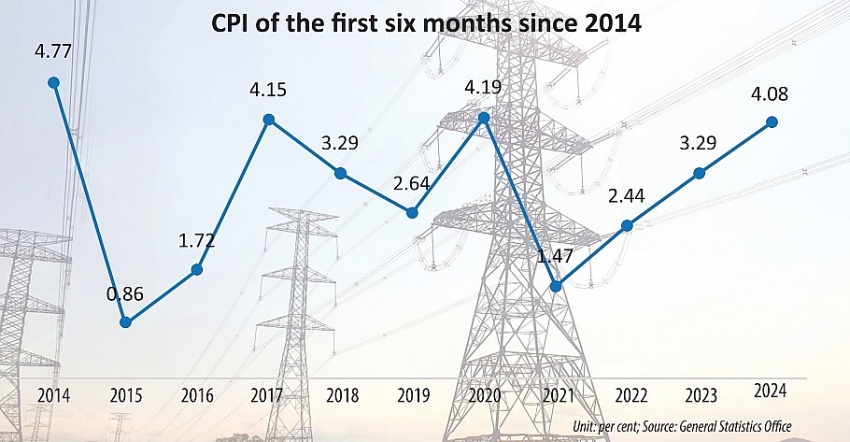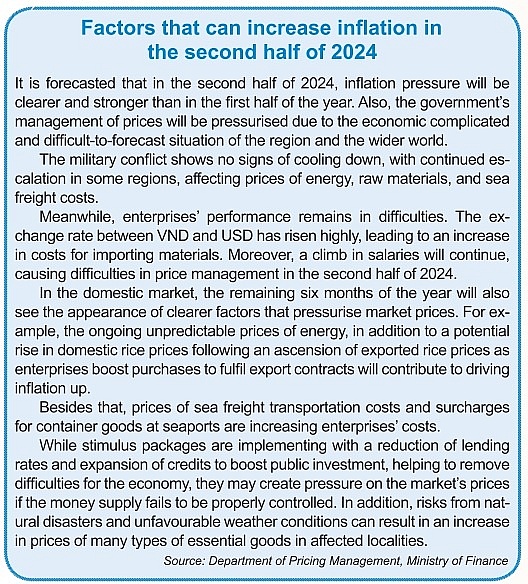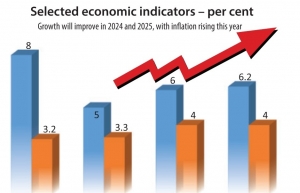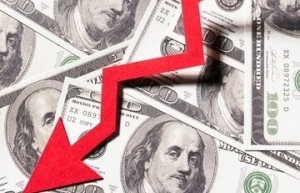Scenarios outline risks during inflation-control efforts
Dr. Le Quoc Phuong, former deputy director of the Commercial and Industrial Information Centre under the Ministry of Industry and Trade (MoIT), told a conference in Hanoi last week that following a high consumer price index (CPI) rise of 4.08 per cent on-year in the first half of 2024, the whole-year rate will likely climb at least 4 per cent or even higher, the same as the target earlier set by the government.
“It is because in the second half of this year, salaries will be increased by 30 per cent for those working in state-owned units, 15 per cent for retirees, and 5 per cent in regions for private-owned companies’ employees,” Phuong said. “In addition, there will also be continued increase in healthcare services, school fees, and electricity.”
Echoing this view, Associate Prof. Nguyen Thuong Lang from the National Economics University’s School of Trade and International Economics, expects that the rate will be very high, at 5-5.5 per cent.
“There are many types of pressures on the CPI increase, such as hikes of salaries, and prices of services of healthcare, education, and electricity,” Lang said.
 |
The MoIT has warned that public demand for electricity and petrol had “suddenly been increasing since early this year,” prompting authorities to devise measures to “ensure electricity and petrol supplies,” which will help bring inflation under control, at about 4 per cent as set earlier by the government.
Fresh figures from the MoIT showed that in the first six months of this year, the electricity volume consumed increased 13.26 per cent on-year – this has outpaced the initial scenario of an on-year rise of 8 per cent.
Since late April, scorching and prolonged sunny weather throughout the country has resulted in a very high increase in consumed electricity. For example, in late April, the peak volume reached 47,670MW, up 13.2 per cent on-year. Notably on May 28, for the first time in the history, the total electricity volume consumed exceeded one billion kWh.
In the first half of 2024, electricity’s price increased 9.45 per cent because of a rise in power demand and Vietnam Electricity raising electricity prices in 2023. This has led to a 0.31 per cent climb in the CPI.
This may contribute to an increase in prices in the market, affecting the government’s efforts to control inflation.
According to the General Statistics Office (GSO), a hike in power prices contributed to an on-year rise of 3.25 per cent in the consumer price index (CPI) last year. Specifically, the price of household electricity rose 4.86 per cent, leading to a 0.16 per cent increase.
However, Dr. Nguyen Duc Do, vice director of the Institute of Economics and Finance under the Academy of Finance, has forecasted that under his three CPI scenarios for the entire year, the average CPI will ascend by around 3.6, 3.4, and 3.2 per cent, respectively.
“Overall, if there will be no large-scale price adjustments for goods managed by the government, from now until the year’s end, the average CPI may grow 3.4 per cent,” Do said.
He explained that though the CPI rose 4.08 per cent on-year in the first half of this year, inflation pressure in the latter half of the year “will not be big”.
“Though the domestic consumption has gradually been recovering, it remains weak, and in the 2020-2024 period, the growth rate of domestic consumption was always lower than that of GDP, at about 3.9 per cent a year. Currently, enterprises are finding ways to boost sales instead of increasing product prices,” Do explained.
In addition, according to Do, though the exchange rate strongly increased in the first six months – by 4.17 per cent against December 2023 and 7.66 per cent on-year, and by 5.64 per cent from January to June, the six-month CPI is not so high similarly. Moreover, the increase of the exchange rate has begun to slow down in May and June and is forecast to stay stable and even reduce in the second half of the year when Fed is expected to reduce interest rate 1-2 times, and the USD may be depreciated in the international market.
Do also projected that over the past months the oil price in the international market has been relatively stable, sitting at around $80 per barrel, which “will be difficult to strongly increase in from now until the year’s end due to a slowdown in the US’ economic growth.”
“I think that the CPI in the second half of 2024 will be almost the same as in the first half of the year, if there will be no sizable price adjustments,” Do said.
 |
The Ministry of Finance has made 2024 CPI forecasts, at 3.64-4.5 per cent, while the GSO’s projections sit at 3.8-4.5 per cent, and the prediction of the State Bank of Vietnam is 4.3 per cent.
“If the monthly CPI rises similarly in the second half of 2024, meaning at 0.26-0.39 per cent, the government will succeed in controlling inflation at 4-4.5 per cent this year,” said economist Ngo Tri Long.
 | Inflation pressure to potentially moderate for Vietnam Although upcoming increases in electricity and salaries will pressurise inflation, a reduction in purchasing power could make it possible for the government to control it. |
 | Recent data adds to Fed confidence on cooling inflation: Powell Federal Reserve Chair Jerome Powell said Monday that recent data boosts the central bank's confidence that inflation is coming down towards its two percent target -- a trend that signals interest rate cuts on the horizon. |
What the stars mean:
★ Poor ★ ★ Promising ★★★ Good ★★★★ Very good ★★★★★ Exceptional
Related Contents
Latest News
More News
- Protect what’s next: towards a future free from meningococcal group B disease (December 05, 2025 | 18:00)
- New ILO report offers policy recommendations for disability inclusion (December 04, 2025 | 15:18)
- Maternal job loss may affect children’s mental health, research shows (December 03, 2025 | 19:11)
- Women lead Vietnam’s shift to climate-resilient agriculture (December 03, 2025 | 19:10)
- Experts highlight unpaid care work as key barrier to gender equality (December 03, 2025 | 15:15)
- Opportunities and inequalities for women workers in Vietnam's garment industry (December 03, 2025 | 09:00)
- Vietjet flights carry love to devastated central region (November 28, 2025 | 11:35)
- New initiative to boost the fight against domestic violence (November 26, 2025 | 10:00)
- South Korea funds IOM relief for Vietnam’s typhoon-affected communities (November 24, 2025 | 15:33)
- AI and human-centred values set to shape the future of HR in Vietnam (November 21, 2025 | 18:04)

 Tag:
Tag:





















 Mobile Version
Mobile Version